The Best DOS Driving Games - Part 2
27th October 2023
As we continue our look at the best driving games on the DOS platform, we come to the early 90s: a time when 3D gaming was still in its infancy but we had already seen a few titles that had shown what could be possible.
Here's the list of driving games we'll look at in this part:
Part 2 - 1990-1992
|
4D Sports Driving / Stunts (Mindscape/Broderbund, 1990)
See also my dedicated game page for 4D Sports Driving.
4D Sports - Driving, marketed as Stunts in the US, created an open-world 3D driving experience, moved it to be a stunt track-oriented game, and made it expandable. As the title screen proudly announces, it was developed by the same team that brought us Test Drive and Test Drive II: The Duel. It was something like a blend of Stunt Car Racer (Microstyle, 1989) and Vette! (Spectrum Holobyte, 1989). One of the best bits of the game was the built-in track designer, so after you had exhausted the six tracks provided in the game, you could easily create your own.
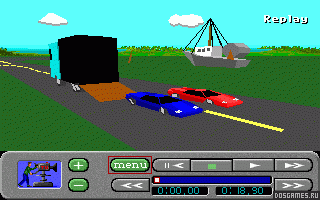 The game had six opponents of varying difficulty to race against, and a decent selection of 11 vehicles, ranging from sports cars to a Formula One car and an SUV.
The game had six opponents of varying difficulty to race against, and a decent selection of 11 vehicles, ranging from sports cars to a Formula One car and an SUV.
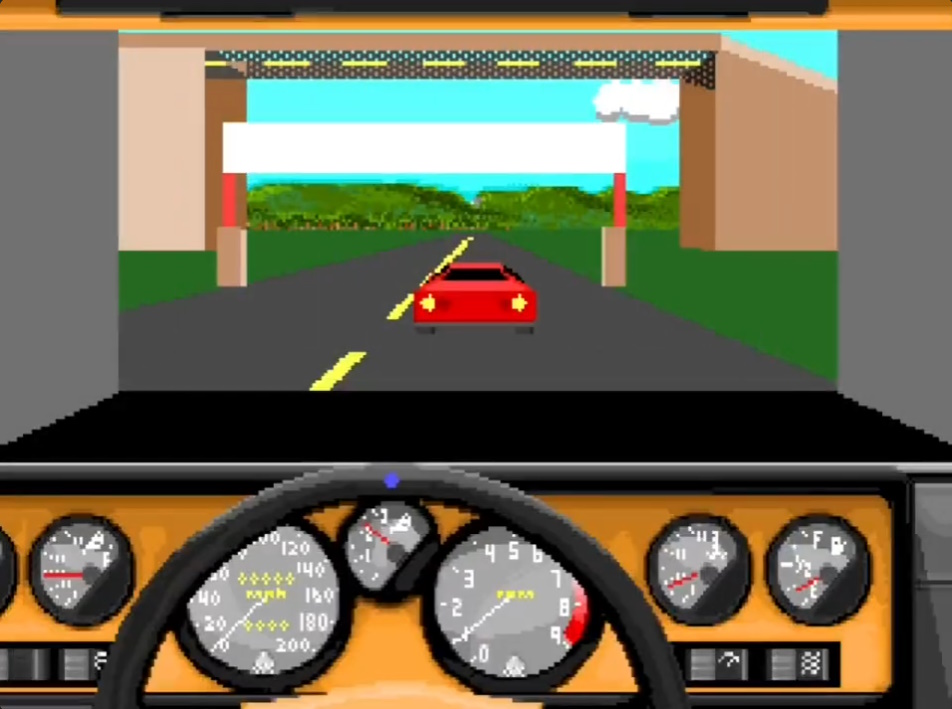 For an early 3D driving game, these days the models look blocky, stretched, and lacking in detail, but the beauty of 4D Sports Driving was in its gameplay. Driving took a little bit of getting used to, where a beginner would find it easy to spin out on a sharp corner or take a jump too fast, resulting in a crash. But if you took your time, got to know the track and your car well, the game was very rewarding. Practice makes perfect with this game.
For an early 3D driving game, these days the models look blocky, stretched, and lacking in detail, but the beauty of 4D Sports Driving was in its gameplay. Driving took a little bit of getting used to, where a beginner would find it easy to spin out on a sharp corner or take a jump too fast, resulting in a crash. But if you took your time, got to know the track and your car well, the game was very rewarding. Practice makes perfect with this game.
There are numerous sound options including Ad Lib, Tandy/PCjr, Sound Blaster and Roland MT-32. The graphics options are also impressive, ranging from Hercules, CGA, Tandy, EGA and MCGA. 4D Sports Driving will run on an XT (8088 or 8086) but is best-performing on at least a 386DX-25. Several performance-related tweaks can be made under 'Options->Graphic Detail' if you find your PC is struggling to give you a decent frame rate.
Pixelmusement's ADG YouTube channel covered some tests of the AI cars in Stunts, and found that the descriptions of the drivers aren't quite what you would expect. The AI drivers will try to follow a precise invisible line around the track unless the player car is close by. Their various strengths and weaknesses also differ from what you can read about them, with Cherry Chassis for example cornering sooo slowly that even Bernie is usually faster at completing a course, even though Cherry goes on straights at a faster speed. He also noticed that certain road surface types have a top speed regardless of the vehicle they are driving in. Otto, despite being the second-worst AI driver is curiously better overall than some others who are supposedly better. In short, the AI is pretty basic in this game, so don't expect too much from it.
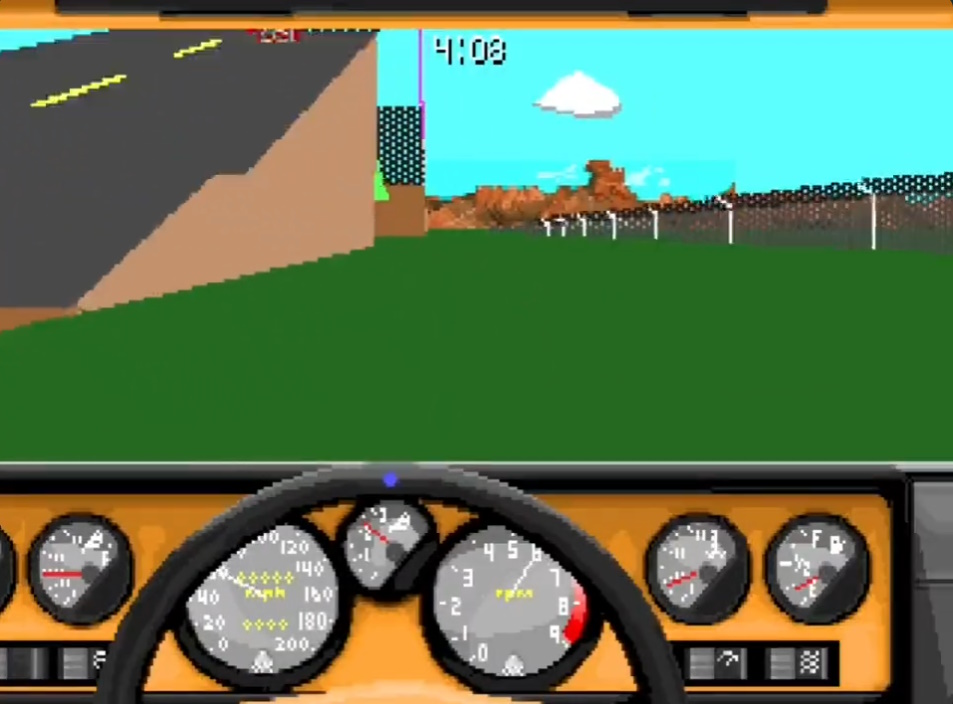 The game had quite the following in the 90s and still does today, with several modding sites offering more cars than you could wish for (creating a new car is best left to the experts - it's a long and complex process!), and hundreds more tracks to try out. They run regular competitions and post individuals' times based on replays they have submitted.
The game had quite the following in the 90s and still does today, with several modding sites offering more cars than you could wish for (creating a new car is best left to the experts - it's a long and complex process!), and hundreds more tracks to try out. They run regular competitions and post individuals' times based on replays they have submitted.
This has no doubt breathed new life into a game this old, and helps keep you coming back for more to try and beat other human players' best times around a particular track.
Sound: Great music and sound effects help to round off this title, especially when compared to what we've had before. Ad Lib, Sound Blaster and Roland options mean there's something for everyone. Engine sounds are decent enough and help you get a feel for your speed/revs. 7/10
Gameplay: Just beautiful! The cars control and feel just about right, with a 'weight' you would expect. You'll need to practice to get a good time and avoid crashing every few minutes, but it's a fun racer. The opponents you race against are different enough (though take note of the comments on AI above), the range of cars and tracks is good, and the fact you can create your own tracks is an excellent addition. 8/10
Lastability: Two things stand out that help keep this game interesting after your first few hours of play: the track editor and the third-party community who have put together a massive library of new vehicles and tracks. Not many games from the 90s outside of the flight sim genre can claim to still have an active fanbase working on new content, but if you like the base game there is a ton of extras and human players you can compare your time trials to, that will keep you occupied for a very long time! 9/10
OVERALL: 8/10
Hard Drivin' (Domark, 1990)
Domark's Hard Drivin' started life as a sit-down arcade cabinet, first launched in February 1989. It was incredibly popular, with both manual and automatic transmissions available, good sense of speed, a force feedback steering wheel and either 3 or 5 screens for a 'wraparound' effect as you sat in the seat for top-notch authenticity. It arrived as a port on the 8- and 16-bit home computers shortly after but many of these were criticised for their "slideshow" frame rates and monochrome graphics. In March 1990 we got the DOS version which I'm reviewing here.
 The game is similar in its design goals to 4D Sports Driving / Stunts, but fails to hit the mark even closely, with even the VGA graphics option only making use of 16 colours and no sound card support.
The game is similar in its design goals to 4D Sports Driving / Stunts, but fails to hit the mark even closely, with even the VGA graphics option only making use of 16 colours and no sound card support.
Both the stunt track and the speed track from the arcade are reproduced, but while the game is colourful in EGA and VGA modes it is choppy to play, the steering, braking and acceleration is slow to take inputs and vague, with the steering itself only able to make small adjustments left or right. Running it on a much faster system does not help - the frame rate is arguably pretty good, but the driving physics are flawed - if you try to take a corner too fast, you hear a squeal and your car is pointed further in the direction you were steering. This detracts from what might have been quite a fun little driving game. Comparing it to 4D Sports Driving, there is no comparison - the amount of content in Hard Drivin' is tiny with just one track, no option to select a different vehicle, no track editor, and the sluggish controls make it just painful to play.
You can play with keyboard, joystick or even a mouse, which is good. I mentioned the keyboard inputs are slow to take effect. With mouse control, at least you can more quickly put the wheel into full lock left or right, but this then throws your car into a skid, so you still need to be careful not to apply too much at once. Arguably, it's almost easier to control the car using the mouse, as the input is accepted that little bit more quickly than with the keyboard. The same is true when using an analogue joystick.
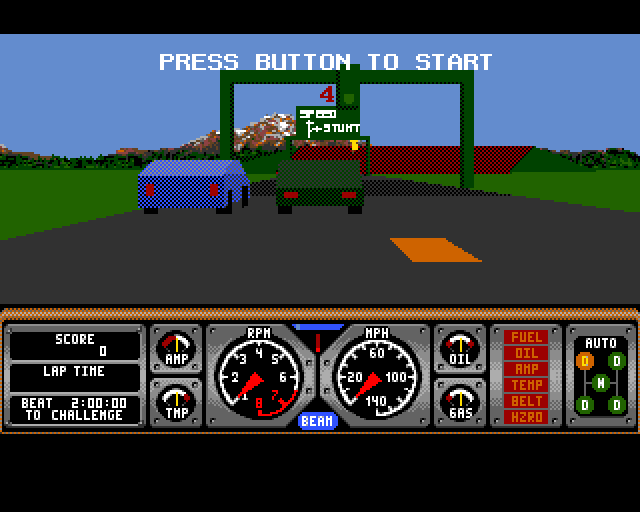 It may feel like an open world title but don't be fooled - go even a smidge off the tarmac and you have 10 seconds to get back on, otherwise you will automatically crash. Hard Drivin' does show you about 7 seconds of instant replay after your crash in a kind of helicopter view, but there is no facility to control camera angles or save a replay to disk. A crash simply delays your progress, as you are positioned back on the track a little way back from where the crash occurred.
It may feel like an open world title but don't be fooled - go even a smidge off the tarmac and you have 10 seconds to get back on, otherwise you will automatically crash. Hard Drivin' does show you about 7 seconds of instant replay after your crash in a kind of helicopter view, but there is no facility to control camera angles or save a replay to disk. A crash simply delays your progress, as you are positioned back on the track a little way back from where the crash occurred.
Barriers are placed at strategic locations to try to prevent you from skipping past some of the stunts, and if you do try to get around them, you may or may not be successful - I tried going around the loop and while it worked, rejoining the track appeared to get my car stuck in a 10-second bout of falling through the ground before crashing into nothing.
No sound card support also aligns with our assumptions on just how rushed this game was - with cringy music and pretty awful engine sounds, this game is best avoided.
The only redeeming feature of Hard Drivin' is that you could run it on pretty basic PC hardware, with an 8088 or 8086 computer, and the full range of graphics standards is included (though as mentioned VGA only runs in 16 colours). Given a decent PC, the frame rate of the game isn't bad.
Sound: PC speaker music and sound effects are, as you would expect, awful - it's 1990, the Ad Lib card has been out for 3 years already so there's really no excuse not to provide some nice FM synth sounds. 2/10
Gameplay: Only one track is available, which splits into the speed or stunt portion. I guess it's true to the arcade game, right? The same with having just the one car you can drive. The 3D world drawing is accurate though buggy in parts where you can see cars behind hills. The car physics aren't good and the controls are just awful, making this game a test of patience and frustration to play. The delay you get with keyboard inputs means you're rarely in control of the car. 4/10
Lastability: Not much to keep you interested here. One track, one car, one player. If you can get around the problems this game has, bravo - I coundn't. Bad ports of arcade games are commonplace, and this is nothing new. But many ports still focus on trying to make it fun to play and the graphics side of it lets it down. This is the reverse - a lot of effort probably went into making a 3D world that they ran out of time on making the game controllable for the home user who doesn't have a steering wheel and pedals.2/10
OVERALL: 4/10
Hard Drivin' II: Drive Harder (Domark, 1990)
Hard Drivin' II: Driver Harder was Domark's attempt to improve upon the fundamentally flawed Hard Drivin'. While they did fix a number of bugs, they failed to correct the biggest flaw in the original - the controls/physics. Instead they opted to do little more than bolt on 4 additional tracks and provide a track editor (probably after seeing what 4D Sports Driving had). There was no improvement in graphics or sound, and even the title screen and overall interface remained the same as in Hard Drivin'. They did add a 'link' feature so you could connect up two PCs, or a PC and an Amiga or Atari ST to have two players compete on the same track.
 They really shouldn't have bothered - what's the point when you still have such little ability to control your car? Does practice make perfect in this case? Not much - I haven't tried, but I reckon if you played this straight for 2 or 3 hours, you wouldn't be crashing so often, but it would be a huge exercise in patience and self-control. Most importantly, it probably wouldn't be fun - no, it's too frustrating to be a fun game. I love games that provide a challenge; that reward your perseverance, but this game is paper-thin in its depth (quite ironic for a 3D game) - if you went straight to the most difficult or fastest car and crash, that's understandable, and you might choose a simpler, slower car to learn on. But there are no other cars in HD2. There are 3 difficulty levels: Easy, Medium and Hard, but I couldn't deduce the difference between them.
They really shouldn't have bothered - what's the point when you still have such little ability to control your car? Does practice make perfect in this case? Not much - I haven't tried, but I reckon if you played this straight for 2 or 3 hours, you wouldn't be crashing so often, but it would be a huge exercise in patience and self-control. Most importantly, it probably wouldn't be fun - no, it's too frustrating to be a fun game. I love games that provide a challenge; that reward your perseverance, but this game is paper-thin in its depth (quite ironic for a 3D game) - if you went straight to the most difficult or fastest car and crash, that's understandable, and you might choose a simpler, slower car to learn on. But there are no other cars in HD2. There are 3 difficulty levels: Easy, Medium and Hard, but I couldn't deduce the difference between them.
 The additional four tracks on top of Hard Drivin's original one are welcome, but even though the track layouts are good there are no new scenery objects to give it a different feel. You also need to exit to DOS and reload the game to change between them. The track editor isn't even in the main game - you run it separately by executing the file EDIT.EXE. The opening screen is text-only before you reach the fairly nice graphical title screen. All of these things culminate into a game that lacks cohesion and confirms that all of its new bits were bolted onto the original game.
The additional four tracks on top of Hard Drivin's original one are welcome, but even though the track layouts are good there are no new scenery objects to give it a different feel. You also need to exit to DOS and reload the game to change between them. The track editor isn't even in the main game - you run it separately by executing the file EDIT.EXE. The opening screen is text-only before you reach the fairly nice graphical title screen. All of these things culminate into a game that lacks cohesion and confirms that all of its new bits were bolted onto the original game.
Hard Drivin' II: Drive Harder seems to be yet another example of a hastily put-together, bug-fixed cash-grab that tries to continue to lean on its amazing arcade roots. - the reviews at the time should be taken with a huge pinch of salt: The One at the time gave HD2 a massive 86% overall score, stating "Even if you own Hard Drivin', Driver Harder in CGA, EGA or VGA with Adlib support and four extra tracks thrown in, is worth the investment." Umm, no it's not. It's about 90% the same as Hard Drivin', and I don't wish to repeat myself [but will anyway], the terrible physics and control mechanism make this sequel just as appalling as the first game. What they needed to do was completely fix the original to make it a viable contender against 4D Sports Driving / Stunts, who pretty much knocked it out of the park on their first try (aside from the "stretched" 3D cars).
Sound: PC speaker music and sound effects are, you guessed it, the same as Hard Drivin'. 2/10
Gameplay: HD2 extends the original title with 4 more tracks, and it's evident they fixed a number of bugs. But no difference in actual gameplay mechanics make this no better than HD. 4/10
Lastability: If you can get around the problems this game has, the two-player link up is a nice addition, as are the 4 more tracks and the track editor which provide extra entertainment over Hard Drivin'. 5/10
OVERALL: 4/10
Test Drive III: The Passion (Accolade/Electronic Arts, 1990)
See also my dedicated game page for Test Drive III: The Passion.
Accolade moved away from using Distinctive Software for its third installment of the Test Drive series, instead choosing the develop it in-house. This was their first 3D-polygon-based driving game, and while its visuals were very appealing, the game was let down badly by a poor control mechanism that made the car difficult to drive.
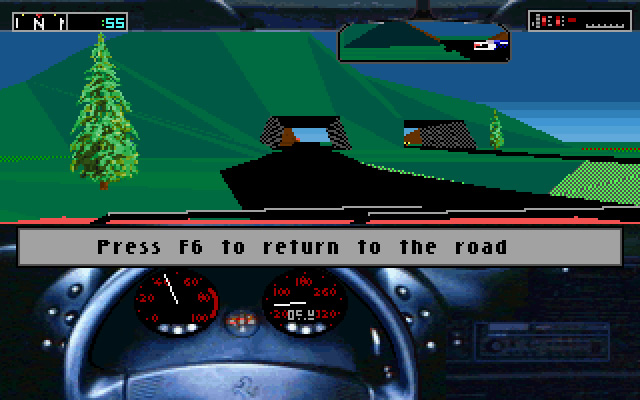 In its favour was true open world driving and a plethora of 3D objects, many of which were animated and moving, such as trains, planes, hot air balloons and lighthouses. The initial game had just three cars you could drive, and only one course that went from the Pacific Coast to Yosemite broken up into five sections, though the world was a good size which allowed for a fair bit of exploration.
In its favour was true open world driving and a plethora of 3D objects, many of which were animated and moving, such as trains, planes, hot air balloons and lighthouses. The initial game had just three cars you could drive, and only one course that went from the Pacific Coast to Yosemite broken up into five sections, though the world was a good size which allowed for a fair bit of exploration.
Hills and mountains feature pretty highly in Test Drive III, and driving up and down them is modelled really well - you can drive across the landscape without fear of crashing, though you will be offered an option to return to the road if you stray too far off the beaten track. Avoiding water is a recommendation - as with every car game, it will end your journey quickly should you fall in.
 Just as with the first two Test Drive games, the main purpose was to get the fastest time over the sections of the route or compete against a computer-controlled driver to reach the end first. Cop cars feature once more to hamper your progress, giving out spot fines that add penalty time to your total.
Just as with the first two Test Drive games, the main purpose was to get the fastest time over the sections of the route or compete against a computer-controlled driver to reach the end first. Cop cars feature once more to hamper your progress, giving out spot fines that add penalty time to your total.
An expansion pack called Road & Car was released the year after, which added a further scenery area from Cape Cod to Niagara Falls and also added two more vehicles.
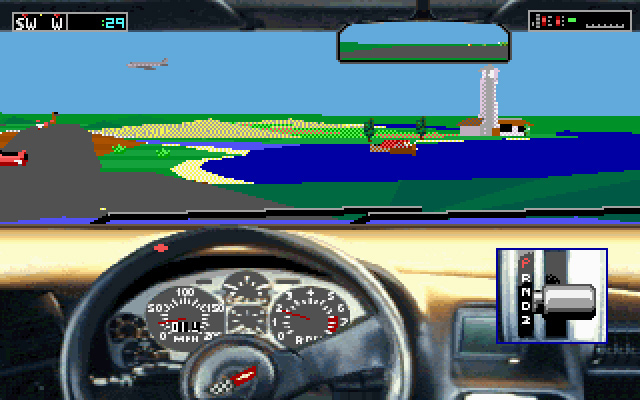 On top of its lovely scenery (which it could run in 256-colour VGA at 320 x 200 resolution), the game provided both day and night driving, weather effects including rain and snow, working headlights that shone out from the front of cars, windscreen wipers, actual digitised dashboards for all driveable cars, a graduating sky and nice shading on 3D models that gave them depth.
On top of its lovely scenery (which it could run in 256-colour VGA at 320 x 200 resolution), the game provided both day and night driving, weather effects including rain and snow, working headlights that shone out from the front of cars, windscreen wipers, actual digitised dashboards for all driveable cars, a graduating sky and nice shading on 3D models that gave them depth.
I do recommend you persevere with Test Drive III - there is much to go and see, and once you get used to the erratic nature of the driving controls you can become much more proficient at feeding just the right amount of steering to keep the car in the direction you want it to go. The physics are, I would say, identical for each of the cars you can drive, so aside from a slight difference in acceleration and top speed there isn't anything new to learn between them. Play game version 2.0 or 3.0 which both have fixes to help correct the driving control issues, and be sure to get your PC's speed period-correct as the game is very speed-sensitive.
Sound: Decent music and sound effects add to the quality of the game, with Ad Lib, Sound Blaster and Roland options. 7/10
Gameplay: Here's where Test Drive III: The Passion becomes a mixed bag. Despite having created a gaming world that is both beautiful and expansive, the control mechanism they developed to drive the cars is too reactive to your inputs - this was somewhat remedied in the version 3.0 release. The game is very speed-sensitive, so running it on anything apart from a 386DX-33 will result in it running slow and jerky or too fast. 6/10
Lastability: The large open-world nature of TD3 means there's plenty to explore once you get bored of the actual racing/time trial aspect of the game. With the Road & Car expansion, this world's size is doubled, so there's even more interesting content that will suck up your time - and you will want to [if you can get a hang of controlling your car]! 8/10
OVERALL: 8/10
Stunt Driver (Spectrum Holobyte, 1990)
My expectations were high for Stunt Driver. Spectrum Holobyte's earlier title that I reviewed in Part 1, Vette! was very open-world but lacked some polish with its limit of 16-colour EGA graphics and was more of a driving-exploring game. Stunt Driver is different, putting you in the role of a stuntman who must navigate a stunt track with loops, chicanes, drawbridges and oil slicks. You race either against the clock (in 'Trainee' mode), or against other stunt drivers. It's more akin to 4D Sports Driving (aka Stunts) in that Stunt Driver also comes with a built-in track editor so you can design and race on your own custom tracks.
 The game not only supports the full suite of PC graphics card standards including 256-colour VGA, but on the audio side Ad Lib, Sound Blaster, Tandy 3-voice, Tandy DAC or IBM PS/1 audio card options are all there too. For those with much lesser systems, Stunt Driver will also run on a humble 286 with a Hercules, CGA or EGA card. The game features a built-in speed test that you see when first starting the game, and this allows you to choose between Slow, Medium or Fast modes, denoting the performance of your PC. In slow mode, you only get PC speaker sound and the 3D objects in the game are simplified for faster animation. Medium gives you Ad Lib or Sound Blaster sound but retains the simple 3D object models, while Fast gives you the best the game can offer.
The game not only supports the full suite of PC graphics card standards including 256-colour VGA, but on the audio side Ad Lib, Sound Blaster, Tandy 3-voice, Tandy DAC or IBM PS/1 audio card options are all there too. For those with much lesser systems, Stunt Driver will also run on a humble 286 with a Hercules, CGA or EGA card. The game features a built-in speed test that you see when first starting the game, and this allows you to choose between Slow, Medium or Fast modes, denoting the performance of your PC. In slow mode, you only get PC speaker sound and the 3D objects in the game are simplified for faster animation. Medium gives you Ad Lib or Sound Blaster sound but retains the simple 3D object models, while Fast gives you the best the game can offer.
There is only one car you can drive, the Shelby Mustang GT500. Competing against you on these tracks are three other cars: a 1987 Porsche 911 Turbo, a 1989 IROC Z, and a 1968 VW Beetle.
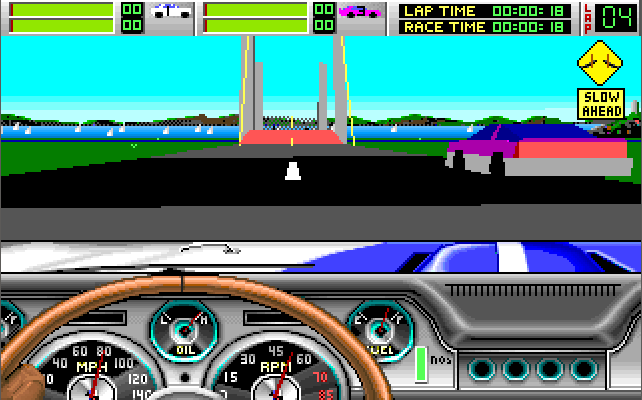 The game has a good frame rate but sadly the 'feel' of driving the car is far too simplistic and arcade-like. The car has no sense of weight to it, and the driving physics are incredibly basic. This detracts from what could otherwise be a fun driving game. The VGA graphics aren't used to the full, looking much closer to 16-colour EGA apart from a few telltales like the gradiated sky and distant landscape. You do have the freedom to go 'off-piste' but really it's a track-based racer, and your car doesn't drive well off the black stuff.
The game has a good frame rate but sadly the 'feel' of driving the car is far too simplistic and arcade-like. The car has no sense of weight to it, and the driving physics are incredibly basic. This detracts from what could otherwise be a fun driving game. The VGA graphics aren't used to the full, looking much closer to 16-colour EGA apart from a few telltales like the gradiated sky and distant landscape. You do have the freedom to go 'off-piste' but really it's a track-based racer, and your car doesn't drive well off the black stuff.
The built-in recorder is a nice touch with load and save features for playback of your favourite bits later, but the controls for this are a bit limited.
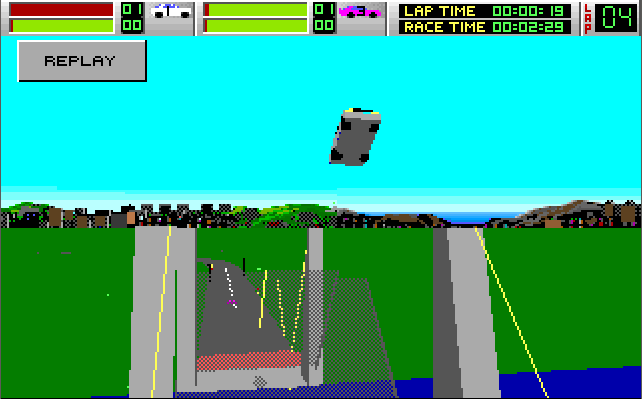 Both when driving and using the replay feature, it's not obvious but you can view other cars with F7 as well as an external camera view by using F1 through F10. You can also zoom in and out to an extent with the minus and equals keys. I'm not sure why they didn't have buttons on the VCR for all of these. Something that is unique to Stunt Driver is the ability to put custom cameras around the track which can then be used in-game and in replay mode using F8 to switch to custom camera view, then F9 and F10 to cycle through them.
Both when driving and using the replay feature, it's not obvious but you can view other cars with F7 as well as an external camera view by using F1 through F10. You can also zoom in and out to an extent with the minus and equals keys. I'm not sure why they didn't have buttons on the VCR for all of these. Something that is unique to Stunt Driver is the ability to put custom cameras around the track which can then be used in-game and in replay mode using F8 to switch to custom camera view, then F9 and F10 to cycle through them.
In summary, the whole game still feels a bit basic and clunky. The scenery options are sparse and as mentioned the controls are too simplistic. The 3D cars and other models aren't particuarly detailed either. All of this adds up to a game that misses the sweet spot between fun arcade racer and driving sim. This is another title that will run on fairly rudimentary PC hardware if that's all you have, but on a premium PC you'll likely find it lacking in graphical fidelity and gameplay.
Sound: No music but the sound effects in Ad Lib or Sound Blaster mode are ok. The game also has some mediocre attempt at speech with 'Stunt Driver' being said on the title screen, and 'Too Fast!' if you're taking a corner too quickly. 6/10
Gameplay: Stunt Driver really lets the side down in several areas here. Yes, the car is controllable (unlike Hard Drivin'), but it feels too simplistic with little sensation that you're actually stuck to the road. The track editor is welcome, but the number of different stunts and track objects to choose from is pretty low, which means there is little extra value in creating your own circuits. The same goes for the lack of variation in the cars - just 3 opponents and you, all stuck in the same vehicle type. 5/10
Lastability: There's not enough to draw you in for very long here - the game comes with five standard courses, and a number of custom courses to race on, but due to the lack of graphical fidelity and relatively few stunt types and other scenery, it's hardly a thing of beauty. Yes it has the track editor but why bother when it's all so similar? 5/10
OVERALL: 5/10
Mario Andretti's Racing Challenge (Electronic Arts, 1991)
Whenever I hear of a title that's got someone's name attached to it, I immediately assume the worst. It's a marketing plug that's been rushed into the stores for a particular event, and will lack polish and decent gameplay. Let's see....
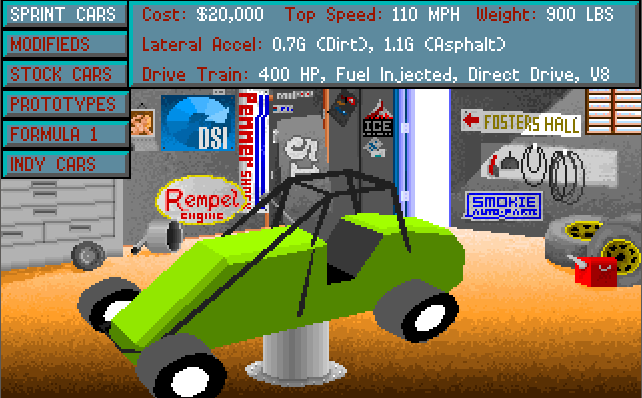 Developed by Distinctive Software and released in 1991, it differed from previous racing games in that it has a career mode that tracks Mario Andretti's racing career through six series, from sprint cars right through to Formula One and Indycar. Featuring 12 tracks, you race in just 1 car of each series. With sponsorship seed money to start you off, you must progress through up to three levels in each series, starting off with a Heat, followed by either a Consolation race if you finished behind the top 3 or the Feature race if you did. The better you do in each race, the more money you get.
Developed by Distinctive Software and released in 1991, it differed from previous racing games in that it has a career mode that tracks Mario Andretti's racing career through six series, from sprint cars right through to Formula One and Indycar. Featuring 12 tracks, you race in just 1 car of each series. With sponsorship seed money to start you off, you must progress through up to three levels in each series, starting off with a Heat, followed by either a Consolation race if you finished behind the top 3 or the Feature race if you did. The better you do in each race, the more money you get.
 Given the career mode of the game, you can save your progress between races and come back to it later.
Given the career mode of the game, you can save your progress between races and come back to it later.
Mario Andretti's Racing Challenge is unfortunately just that - a challenge. I found just getting beyond the sprint cars to be really difficult, and only with a lot of practice can you be competitive further up the series.
The game can run in 256-colour MCGA (synonymous with VGA at 320 x 200 resolution), EGA or Tandy modes. Audio options include the PC speaker, Tandy 3-voice, Ad Lib, Roland MT-32 and the IBM Advanced sound card.
Sound: Decent music and sound effects in Ad Lib, Sound Blaster and MT-32 mode - something we've come to expect of Distinctive Software. 8/10
Gameplay: Controlling the cars is slightly different for each series, but was it enough to make me feel I'm in that type of car compared to another? Not for me. Personally I found the game's difficulty was just too great to make this enjoyable, and there are no actual difficulty levels you can choose from. I've read other reviews where folks got further into the game and it supposedly really opens up, but I'll have to take their word for it. When we've already had Indianapolis 500: The Simulation, which offered impeccable realism and physics coupled with decent graphics, this is a letdown. Its one saving grace is the depth that the career mode offers. 5/10
Lastability: With its career mode, I'm sure this could keep anyone occupied for many many hours - if you can get there. Since I was unable to progress very far, I cannot give this more than 6 out of 10 due to game's lack of 'accessibility'. By this I mean the complete absence of choices to jump straight into a race for any of the series. The only way to get into some serious action is to make the slow progress through the career mode. 5/10
OVERALL: 6/10
Car & Driver (Electronic Arts, 1992)
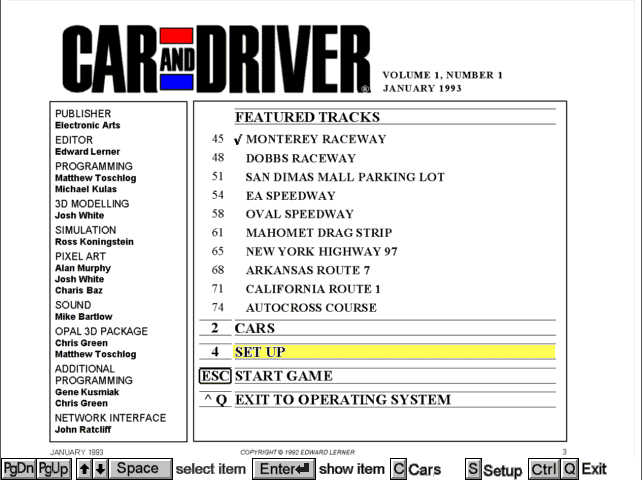 Car & Driver was sponsored by the publishers of the Car & Driver magazine. To this end, the game's configuration is made to appear as though you're thumbing through the magazine. The focus in this game is on the car - ten in all, including the best from Ferrari, Lamborghini, Lotus and Porsche, plus a good number of others.
Car & Driver was sponsored by the publishers of the Car & Driver magazine. To this end, the game's configuration is made to appear as though you're thumbing through the magazine. The focus in this game is on the car - ten in all, including the best from Ferrari, Lamborghini, Lotus and Porsche, plus a good number of others.
There are also ten tracks which do a pretty good job of mimicking the real circuits and roads they are designed to represent. These range from raceways in the US to a mall parking lot and the famous California Route 1, the Pacific Coast Highway.
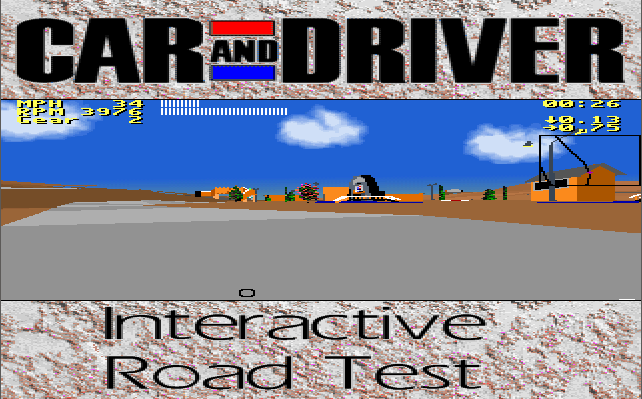 Sadly the game dynamics come across as more of a 3D modelling demo than a game. This is reinforced by the complete lack of any competition to race against, or any other road/track users present in the game - you're alone, apart from some cars crawling round the shopping mall car park. I may have got that wrong, since the game does support multiplayer over a network link - how many can connect at once I'm not sure and I never tried it.
Sadly the game dynamics come across as more of a 3D modelling demo than a game. This is reinforced by the complete lack of any competition to race against, or any other road/track users present in the game - you're alone, apart from some cars crawling round the shopping mall car park. I may have got that wrong, since the game does support multiplayer over a network link - how many can connect at once I'm not sure and I never tried it.
In high-resolution mode, two thirds of the visual display area are taken up by huge banners top and bottom, and the font that shows your speed, rpm, lap time and so on have that skewed/stretched effect. In low-res modes (with dashboard and without), the view becomes full-screen, but these are only available from the view behind the wheel - if you opt for one of the external views, it goes back into high-res mode with the ugly banners.
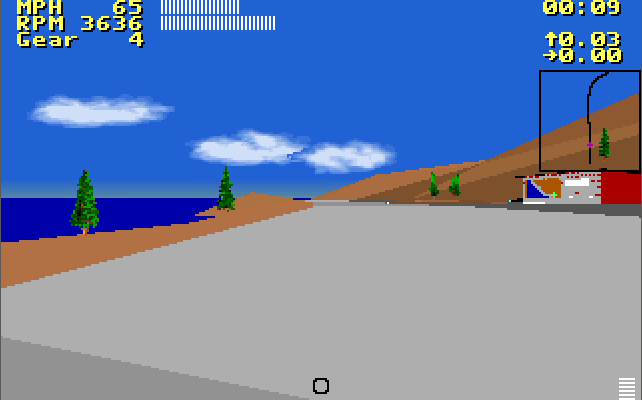 If you veer off the road, steering becomes almost impossible, though it does give you a prompt to press 'Q' to return to the road.
If you veer off the road, steering becomes almost impossible, though it does give you a prompt to press 'Q' to return to the road.
The game does come with a replay feature but unlike other games that have this there's no interface to conveniently switch camera views. The F1-F10 keys change your field of view, which takes an age to change as it goes up 0.1 degrees at a time.
Ugh, I'm not sure what else to say, except don't bother with this one. Most importantly, It's simply not fun.
Sound: There are 3 radio stations you can switch on, all of which are pretty bad. There are no sound effects apart from the engine sound and a noise when you crash while in-game. Uninspring. 3/10
Gameplay: The controls feel 'heavy' and using the keyboard "steering" left and right is either full-left or full-right - there's no indicator on the wheel like in some other games like the Test Drive series to indicate you are turning the wheel more and more in one direction. As mentioned, the complete lack of other road users or cars to race against makes this more of a graphical 3D demo than a game. It's just boring. 3/10
Lastability: I got to about 30 minutes before switching off - there's just more of the same hum-drum content - another car, another empty track - yawn...2/10
OVERALL: 3/10
Formula One Grand Prix / World Circuit (Microprose, 1992)
See also my dedicated game page for Formula One Grand Prix.
OK, I've been waiting for this one. Microprose have long-been the pros at simulation titles and publishing this, Geoff Crammond's masterpiece, was a solid choice. Crammond had a number of earlier car racing titles dating as far back as 1982 with Revs on the Acorn BBC. What did he learn in 10 years? Well, a ton as it turns out.
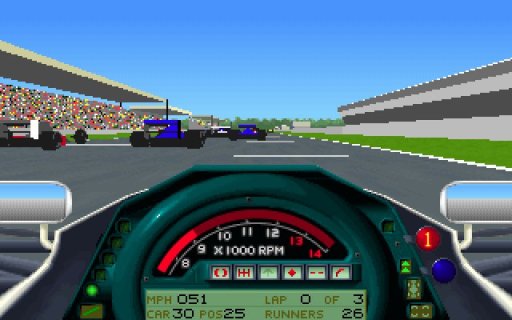 Formula One Grand Prix, known as World Circuit in North America, put you in the cockpit of a Formula One Racing Car, able to take part in either a single race or an entire Grand Prix season. No sponsorship was acquired for this game, so all 36 drivers and 18 team names come out of the box in "made-up" form, but you can edit these to reflect the actual 1991 season (or whatever season you choose) if you like.
Formula One Grand Prix, known as World Circuit in North America, put you in the cockpit of a Formula One Racing Car, able to take part in either a single race or an entire Grand Prix season. No sponsorship was acquired for this game, so all 36 drivers and 18 team names come out of the box in "made-up" form, but you can edit these to reflect the actual 1991 season (or whatever season you choose) if you like.
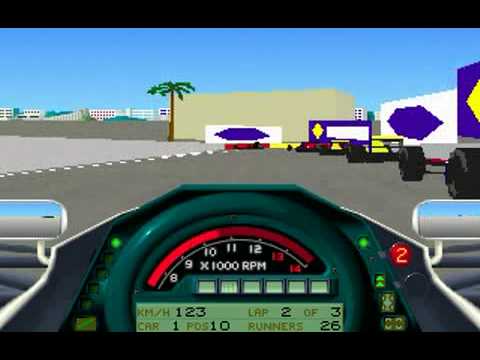 A true 3D racing game, you could race against computer-controlled opponents of varying expertise, just like in real life, or against your fellow humans in several ways. The simplest multiplayer mode is actually very clever - you race for a certain number of laps before being given a timer warning to switch seats with another human player - during this time the computer takes control of your car (and I believe races at a similar standard to the way you've been playing, but don't quote me on that). The view changes to the next human player's car and the timer counts down to zero when they must take over the controls from the computer. This works really well in practice, and gives each player a bit of a break from the action - especially if you're all playing a full race duration of approximately 60-80 laps.
A true 3D racing game, you could race against computer-controlled opponents of varying expertise, just like in real life, or against your fellow humans in several ways. The simplest multiplayer mode is actually very clever - you race for a certain number of laps before being given a timer warning to switch seats with another human player - during this time the computer takes control of your car (and I believe races at a similar standard to the way you've been playing, but don't quote me on that). The view changes to the next human player's car and the timer counts down to zero when they must take over the controls from the computer. This works really well in practice, and gives each player a bit of a break from the action - especially if you're all playing a full race duration of approximately 60-80 laps.
Another way of playing multiplayer is over a network - huge fun and pretty easy to setup, though you need decent PC hardware across all the PCs being connected together to keep the frame rates up.
 The static screens are nicely done, and are full of options to set the game up just as you want it - you can edit your team and driver names, select difficulty levels, graphics options and so on. The static circuit pics are also decent. Most crucially though, its the 3D graphics when racing that are ground-breaking. Crammond didn't shirk on the circuit periphery either, with advertising boards, cheering crowds, cranes, bridges, trees that fade into view and more.
The static screens are nicely done, and are full of options to set the game up just as you want it - you can edit your team and driver names, select difficulty levels, graphics options and so on. The static circuit pics are also decent. Most crucially though, its the 3D graphics when racing that are ground-breaking. Crammond didn't shirk on the circuit periphery either, with advertising boards, cheering crowds, cranes, bridges, trees that fade into view and more.
Given that in a full race you can have 36 cars on-screen at the same time, this game is a marvel of efficient programming. As mentioned before, it demanded a solid PC for its time, but the game provided a number of ways to keep frame rates up on lesser systems, including various detail levels and being able to switch on/off textured markings on the track surface.
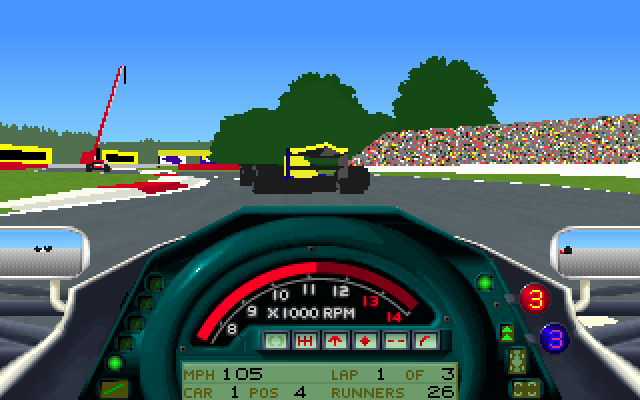 Of course great graphics alone don't necessarily make a good game as we've seen in other driving games in this article. But F1GP, as it was often abbreviated, was a winner all-round due to also having a near-perfect gameplay experience with excellent "weight" to the car and driveability. You'd never feel like a mishap could be blamed on the way the game was written - the mistake was all yours. With plenty of control options from keyboard, joystick and mouse, the joystick control was the best. Configurability here was also important, and you can tell a lot of work went into providing many tweaking options for the huge variation in joysticks available at the time. Steering and 'pedal' axes, their levels of sensitivity, it's all catered for. You can even mix and match joystick and keyboard controls if you want to.
Of course great graphics alone don't necessarily make a good game as we've seen in other driving games in this article. But F1GP, as it was often abbreviated, was a winner all-round due to also having a near-perfect gameplay experience with excellent "weight" to the car and driveability. You'd never feel like a mishap could be blamed on the way the game was written - the mistake was all yours. With plenty of control options from keyboard, joystick and mouse, the joystick control was the best. Configurability here was also important, and you can tell a lot of work went into providing many tweaking options for the huge variation in joysticks available at the time. Steering and 'pedal' axes, their levels of sensitivity, it's all catered for. You can even mix and match joystick and keyboard controls if you want to.
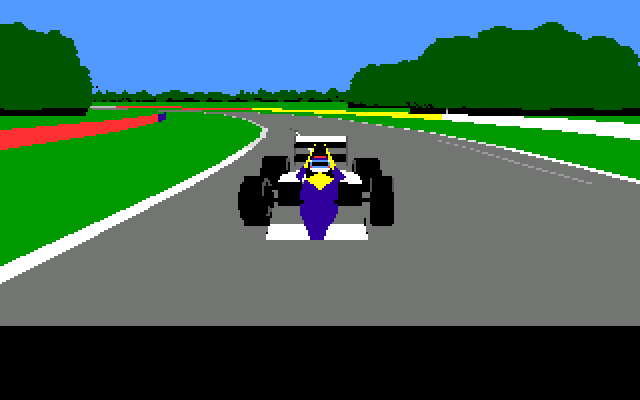 The game was innovative in other ways too. Numerous "driving aids" were available to provide assistance in steering, braking, changing gears (or not), damage (or not), and cornering assistance which would help you follow the apex. This allowed newcomers to get into the action and have fun while they got to grips with the game, and you could switch these on or off whenever you wanted to during a race. Having driving aids enabled did not incur any penalty, which I feel is a good thing. As you got better, you could gradually switch these off. Driving aids like these have been copied by others and are still present in many racing games today.
The game was innovative in other ways too. Numerous "driving aids" were available to provide assistance in steering, braking, changing gears (or not), damage (or not), and cornering assistance which would help you follow the apex. This allowed newcomers to get into the action and have fun while they got to grips with the game, and you could switch these on or off whenever you wanted to during a race. Having driving aids enabled did not incur any penalty, which I feel is a good thing. As you got better, you could gradually switch these off. Driving aids like these have been copied by others and are still present in many racing games today.
 The circuits from the 1991 season have all been faithfully reproduced, including having to pit if a full race length was chosen. Tyre wear and damage would be fixed while pitting, and the pitstop time would naturally increase the more work was needed. In a single race or full season, you would go through the various stages including a practice session which could be set to run from 5 minutes up to 2 hours, qualifying which could be from 15 minutes long to 2 hours, and finally the race which could be set to anywhere from 10% to 100% of the real race distance. As you would expect, for the race it would position you on the grid based on your best qualifying lap compared to the other players, whether computer-controlled or human.
The circuits from the 1991 season have all been faithfully reproduced, including having to pit if a full race length was chosen. Tyre wear and damage would be fixed while pitting, and the pitstop time would naturally increase the more work was needed. In a single race or full season, you would go through the various stages including a practice session which could be set to run from 5 minutes up to 2 hours, qualifying which could be from 15 minutes long to 2 hours, and finally the race which could be set to anywhere from 10% to 100% of the real race distance. As you would expect, for the race it would position you on the grid based on your best qualifying lap compared to the other players, whether computer-controlled or human.
Five difficulty settings exist, from Novice to Ace, and changing this adjusts the capability of the opposition. You can also choose to have the opposition all be at the same level, be set to 1991 season levels, or random.
This game has everything you could want in a Formula One racing sim - great graphics and sound, exceptional gameplay, and great physics that do enough to keep it really fun without you needing a racing license to be able to control it. F1GP became the new benchmark for later titles to meet.
Sound: Good intro music that's similar to the old BBC F1 intro theme, amazing engine sounds - all you would need, unless menu music is important to you, of which there is none. You have the option of Ad Lib, Sound Blaster and Roland MT-32. 9/10
Gameplay: Pretty much the first driving game we've come across that "just gets it right". Having great driving physics, decent AI where the opponents will on occasion crash or make mistakes without your intervention, a multitude of control over the, erm.. controls, and of course the game follows the F1 weekend process for practice sessions, qualifying and race day, and you have marshalls flags to adhere to when certain events occur. 10/10
Lastability: You get a full racing season to keep the tension high, and if that weren't enough, play against (or with) your friends in two-player link up via modem or direct cable. Tons of third-party utilities also open the game up further. Is there anything missing? Nope. 10/10
OVERALL: 10/10
Grand Prix Unlimited (Accolade, 1992)
Released in the shadow of the amazing Formula One Grand Prix (aka World Circuit), Accolade's rival was put together by the same team who brought us Test Drive III: The Passion. Sadly, despite being sponsored by Road & Track, a popular US car magazine, it really didn't shine. The menu visuals were really nice, with low-res photographic shots of the cars from actual teams, but in-game it was another story. Sadly, while this is a 3D title, the quality of these models as well as the gameplay didn't compare against the mighty F1GP.
 You can race as a driver in just five of the teams from the 1990-1992 season: Williams-Renault (the fastest), McLaren-Honda, Ferrari, , Benetton-Ford, or Tyrrell (the slowest). After selecting your team, you choose the circuit to race on, the number of laps (1, 3, 5, 10 or 20), and the number of cars to race against (2, 3, 7, 10 or 16). Choosing the 'Tour' option will take you on a guided single lap of the chosen circuit - a nice touch, and a good way to review the layout before getting behind the wheel yourself.
You can race as a driver in just five of the teams from the 1990-1992 season: Williams-Renault (the fastest), McLaren-Honda, Ferrari, , Benetton-Ford, or Tyrrell (the slowest). After selecting your team, you choose the circuit to race on, the number of laps (1, 3, 5, 10 or 20), and the number of cars to race against (2, 3, 7, 10 or 16). Choosing the 'Tour' option will take you on a guided single lap of the chosen circuit - a nice touch, and a good way to review the layout before getting behind the wheel yourself.
 Your car's setup can be altered by pressing F2 while on a qualifying lap. These options include car height, steering radius, braking ability, front and rear wings, gear ratios and tyres. Your initial team selection is really just a way of providing you with a 'default' car setup from which to start tweaking.
Your car's setup can be altered by pressing F2 while on a qualifying lap. These options include car height, steering radius, braking ability, front and rear wings, gear ratios and tyres. Your initial team selection is really just a way of providing you with a 'default' car setup from which to start tweaking.
Similar to Formula One Grand Prix, Grand Prix Unlimited has a couple of driving aids you can switch on or off, but it's very limited: really just the choice of automatic or manual transmission and the Lane Control System. This one is a little odd as it literally makes every turn for you - all you have to do is control the car's speed and it will do the rest (unlike F1GP's cornering assist, which gives you some help but not everything). Go through a corner too fast and the car will lose traction and come off, but otherwise it will stick to the centre line of the track. These driving aids are in addition to the five difficulty levels of Novice, Easy, Medium, Advanced, and Pro. Depending on the difficulty level you choose, your opponents will have altered top speed, acceleration, and aggresiveness, and your own car will be tougher to control and take damage more easily. Pressing 'M' in a race will toggle the display of a miniature map in the top-left corner - good if you're new to a particular circuit.
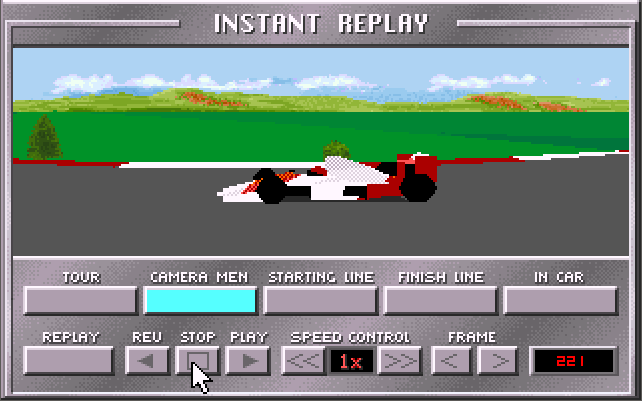 The weather effects in Grand Prix Unlimited are decent, and in practice modes or single races you can set the weather (to sun, mist or rain), but in a championship season this is randomly selected. Racing in rain does alter the driving characteristics
The weather effects in Grand Prix Unlimited are decent, and in practice modes or single races you can set the weather (to sun, mist or rain), but in a championship season this is randomly selected. Racing in rain does alter the driving characteristics
You can use a mouse to control menu selections, but for driving you have the choice of keyboard or digital or analogue joystick.
The game will run on an 80286 16 MHz or faster with 640 KB of RAM, but it's best to have at least a 386 if you want the full graphical fidelity offered. There are three selectable graphical detail levels: low, medium, or high, so if running on a lower-spec PC like a fast 286 this can help keep the frame rates up. I should state that the game is speed-sensitive, so don't play it on too fast-a-machine or you'll need to use slowdown utilities to get it back down to be playable.
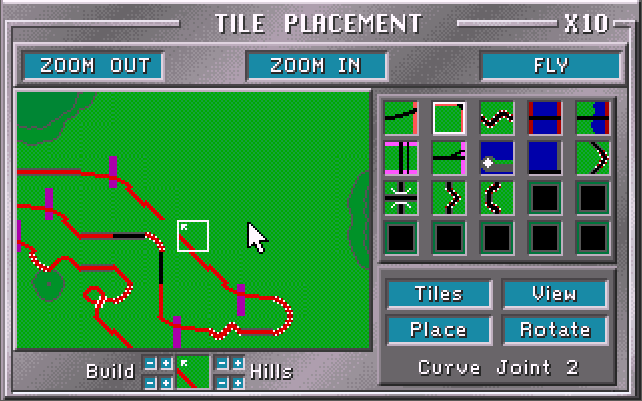 One welcome addition in GPU is the 'Architect'. Selectable from the main menu, it allows you to design your own racing circuit - a first for a Grand Prix game! You're given a slightly different rendition of the music from Test Drive III as you create your track. There are two views when in this mode: in the initial zoomed-out view, you define the course route which allows the game to understand which route the computer-controlled cars should take. Clicking on 'Zoom In' is where you can lay the various track tiles. It feels a bit clunky compared to some other course designers like the one in 4D Sports Driving, but using shortcut keys helps speed things up. The 'Fly' option gives you a controllable helicopter view of the track where you can check everything looks good before committing your changes, and you can also switch to this mode during a race by pressing F4.
One welcome addition in GPU is the 'Architect'. Selectable from the main menu, it allows you to design your own racing circuit - a first for a Grand Prix game! You're given a slightly different rendition of the music from Test Drive III as you create your track. There are two views when in this mode: in the initial zoomed-out view, you define the course route which allows the game to understand which route the computer-controlled cars should take. Clicking on 'Zoom In' is where you can lay the various track tiles. It feels a bit clunky compared to some other course designers like the one in 4D Sports Driving, but using shortcut keys helps speed things up. The 'Fly' option gives you a controllable helicopter view of the track where you can check everything looks good before committing your changes, and you can also switch to this mode during a race by pressing F4.
Despite all the great things they've put into this game, it's too arcade-like in its controls. If you're expecting a direct competitor to Formula One Grand Prix but with a track designer, this isn't it. Lots of nice things and it looks pretty enough, but I still prefer F1GP as an all-rounder F1 sim because it just feels more like a sim and isn't let down by poor engine sounds.
Sound: Who thought it would be a good idea to have music playing while you're racing a Formula One car?! You can switch this off in the in-game settings using F1, but still... The car's engine sound is also just wrong - F1 cars are supposed to scream, but in GPU it's muted and soft, and this detracts from making you feel like you're driving in Formula One (note: I only tested the Sound Blaster mode, so MT-32 might be better in this regard). 5/10
Gameplay: A pretty full Grand Prix title, though you cannot select any particular driver and only five teams are present. Sadly, despite having quite a bit going for it around the periphery, the actual control mechanism of the car isn't up to Formula One Grand Prix standard. Grand Prix Unlimited feels much more arcade-like. 6/10
Lastability: Having many difficulty levels means even a complete novice will be winning races easily, but as you move up the scale things get progressively tougher. The "Architect" mode is also a real boon in an F1 racer, and despite it being a little tricky to work with it does get the job done if you're serious and put the time in. Good job, Accolade. 7/10
OVERALL: 7/10
Race Drivin' (Domark, 1992)
Let's see if Domark was third-time lucky after its dismal Hard Drivin' and bug-fix redux, Hard Drivin' II. Race Drivin' arrived a full two years later and promised similar gameplay to its forebears, with you trying to get the best time around either a stunt track or a speed track. It also added an Autocross track and a Super Stunt track. You also get to drive in either a 'Speedster', 'Sportster' or 'Roadster' in either manual or automatic transmission variants. You can choose your opponent's vehicle as well.
 Playing Race Drivin' it's evident they fixed most of the problems with steering from the first two games, but sadly the redraw distance is very poor - the track in the distance appears far too late for you to react in a timely manner and this gets frustrating fast.
Playing Race Drivin' it's evident they fixed most of the problems with steering from the first two games, but sadly the redraw distance is very poor - the track in the distance appears far too late for you to react in a timely manner and this gets frustrating fast.
Still very much an arcade game, you have to get through checkpoints in the given time and more time is then added on. You continue doing laps of the track until you eventually fail to make the next checkpoint.
 Sadly the game is still only in 16 colours, and for 1992 this is a real shame, though the dithering is acceptable. The game was re-released in 1995, adding sound card support which included Ad Lib, Sound Blaster, Roland and Tandy.
Sadly the game is still only in 16 colours, and for 1992 this is a real shame, though the dithering is acceptable. The game was re-released in 1995, adding sound card support which included Ad Lib, Sound Blaster, Roland and Tandy.
With only three tracks to choose from and three cars which really aren't any different from one another, Race Drivin' is lacking across the board. The scenery is bland and unless you opt for the two-player link up option where you can race against another human player, there is little to hold your attention for very long.
This is all too little, too late, and for 1992 this game doesn't match up to any of the other racing titles, whether arcade-like or not. Domark should have given up on this two years ago after failing right out of the gate with Hard Drivin'. They all made good arcade games with a seat, steering wheel and pedals, but to port it to home platforms was a mistake.
Sound: The 1995 re-release with sound card support is welcome - don't even bother with PC speaker only - there's no engine sound while driving which makes this come across as a 3D driving demo rather than a complete game. 3/10
Gameplay: They fixed the steering issues from the first games, but the rest of it is still the same as in Hard Drivin' and its sequel. It's just not very fun to play. 3/10
Lastability: With only three tracks and no option to build your own as we've seen in other racing or stunt games, you won't be playing this for very long. 4/10
OVERALL: 4/10
Toyota Celica GT Rally (Gremlin, 1992)
Gremlin have a great track record (pun intended) at producing great arcade racer games on the 8-bit and 16-bit home computers, including the Lotus series. With endorsement from Toyota for this title, I had mixed opinions going into this mini-review. It was developed by Astros Productions, whoever they are.
 Toyota Celica GT Rally runs in either 16-colour EGA or 256-colour VGA mode, and supports Ad Lib, Sound Blaster, and Roland MT-32 sound. After choosing your level of steering sensitivity, you are presented with a screen that mis-names the title as 'Toyota World Rally'.
Toyota Celica GT Rally runs in either 16-colour EGA or 256-colour VGA mode, and supports Ad Lib, Sound Blaster, and Roland MT-32 sound. After choosing your level of steering sensitivity, you are presented with a screen that mis-names the title as 'Toyota World Rally'.
You have the option to race against up to four players on three rally courses: Britain, Mexico and Finland and each are split into stages. Each course has different scenery to reflect the country you're in.
 Unfortunately, there are no redeeming features of this game. The graphics are like you would get on an Amiga or Atari ST - very colourful but simplistic. The gameplay is the same regardless of the course you choose. Crashing your car will incur a 20-second penalty, but the current driver continues until you have completed the stage. When this happens, the next driver (if you opted for 2-4 players) will take over and do that stage also.
Unfortunately, there are no redeeming features of this game. The graphics are like you would get on an Amiga or Atari ST - very colourful but simplistic. The gameplay is the same regardless of the course you choose. Crashing your car will incur a 20-second penalty, but the current driver continues until you have completed the stage. When this happens, the next driver (if you opted for 2-4 players) will take over and do that stage also.
The music jingle is nice enough but the engine sound is messed up. But the worst thing about TCGR is that it feels floaty - the car just isn't planted on the road.
 Even the menu system appears to have been rushed - once you make a selection there is no going back to change it - you must go through into starting to race, then exiting to get back.
Even the menu system appears to have been rushed - once you make a selection there is no going back to change it - you must go through into starting to race, then exiting to get back.
I don't know what else to say, except to avoid this one. I prefer the old Lombard RAC Rally to this, and that's saying something! It's not a sim, and it even manages to miss the mark at being a decent arcade racer.
Sound: A nice jingle while you're in the menu and when driving, but no variation at all. Sound effects don't work right, and since part of racing is to know your revs, this is a complete miss. 3/10
Gameplay: Floaty car with no feel at all - just appalling. I sense this game was a rushed port from another platform with little thought in trying to make it something fun to play. 1/10
Lastability: You'd have to be super patient to even last a whole course in this game - it's the same boring gameplay just with different scenery. 2/10
OVERALL: 2/10
So to end this look at the second batch of DOS driving games, I will summarise the scoreboard:
|
|
|
|
|
|
|
With the arrival of the excellent F1GP (World Circuit) setting the benchmark for future racing games, and 4D Sports Driving (Stunts) which was both fun and expandable, we were treated to some seminal works in this time period. Test Drive III: The Passion gave us some beautiful 3D eye candy in an open world, and Grand Prix Unlimited made a passable effort at trying to be F1GP but just missed the mark. Along the way were also some utterly terrible ones though.
If you're enjoying this trip down memory lane, Part 3 is ready and waiting for you, where we draw towards the mid-1990s, and new CPUs and faster graphics cards push the envelope!






